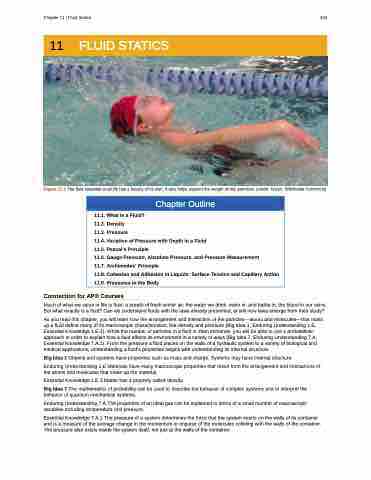Page 457 - College Physics For AP Courses
P. 457
Chapter 11 | Fluid Statics 445
11 FLUID STATICS
Figure 11.1 The fluid essential to all life has a beauty of its own. It also helps support the weight of this swimmer. (credit: Terren, Wikimedia Commons)
Chapter Outline
11.1. What Is a Fluid?
11.2. Density
11.3. Pressure
11.4. Variation of Pressure with Depth in a Fluid 11.5. Pascal’s Principle
11.6. Gauge Pressure, Absolute Pressure, and Pressure Measurement
11.7. Archimedes’ Principle
11.8. Cohesion and Adhesion in Liquids: Surface Tension and Capillary Action 11.9. Pressures in the Body
Connection for AP® Courses
Much of what we value in life is fluid: a breath of fresh winter air; the water we drink, swim in, and bathe in; the blood in our veins. But what exactly is a fluid? Can we understand fluids with the laws already presented, or will new laws emerge from their study?
As you read this chapter, you will learn how the arrangement and interaction of the particles—atoms and molecules—that make up a fluid define many of its macroscopic characteristics, like density and pressure (Big Idea 1, Enduring Understanding 1.E, Essential Knowledge 1.E.1). While the number of particles in a fluid is often immense, you will be able to use a probabilistic approach in order to explain how a fluid affects its environment in a variety of ways (Big Idea 7, Enduring Understanding 7.A, Essential Knowledge 7.A.1). From the pressure a fluid places on the walls of a hydraulic system to a variety of biological and medical applications, understanding a fluid's properties begins with understanding its internal structure.
Big Idea 1 Objects and systems have properties such as mass and charge. Systems may have internal structure.
Enduring Understanding 1.E Materials have many macroscopic properties that result from the arrangement and interactions of
the atoms and molecules that make up the material.
Essential Knowledge 1.E.1 Matter has a property called density.
Big Idea 7 The mathematics of probability can be used to describe the behavior of complex systems and to interpret the behavior of quantum mechanical systems.
Enduring Understanding 7.A The properties of an ideal gas can be explained in terms of a small number of macroscopic variables including temperature and pressure.
Essential Knowledge 7.A.1 The pressure of a system determines the force that the system exerts on the walls of its container and is a measure of the average change in the momentum or impulse of the molecules colliding with the walls of the container. The pressure also exists inside the system itself, not just at the walls of the container.


